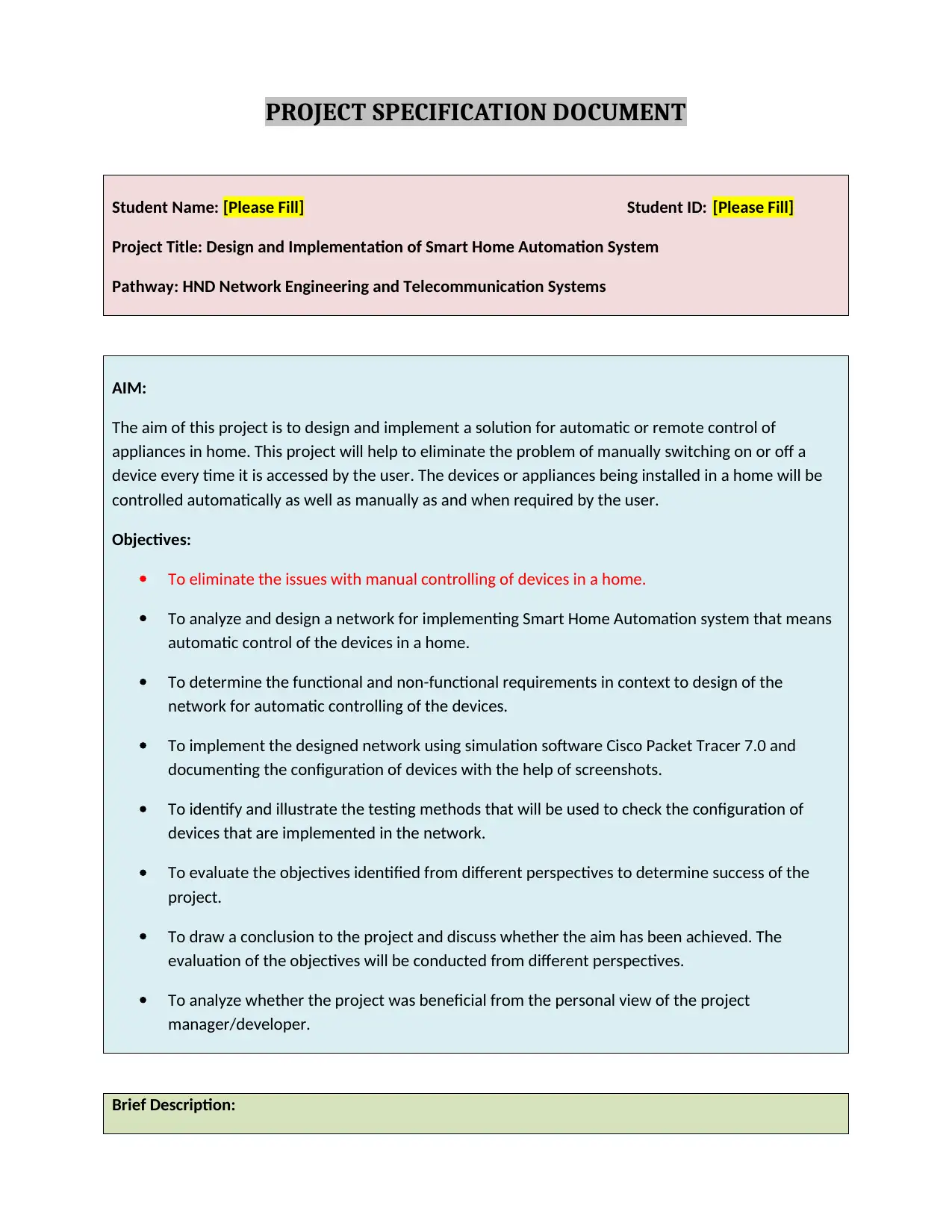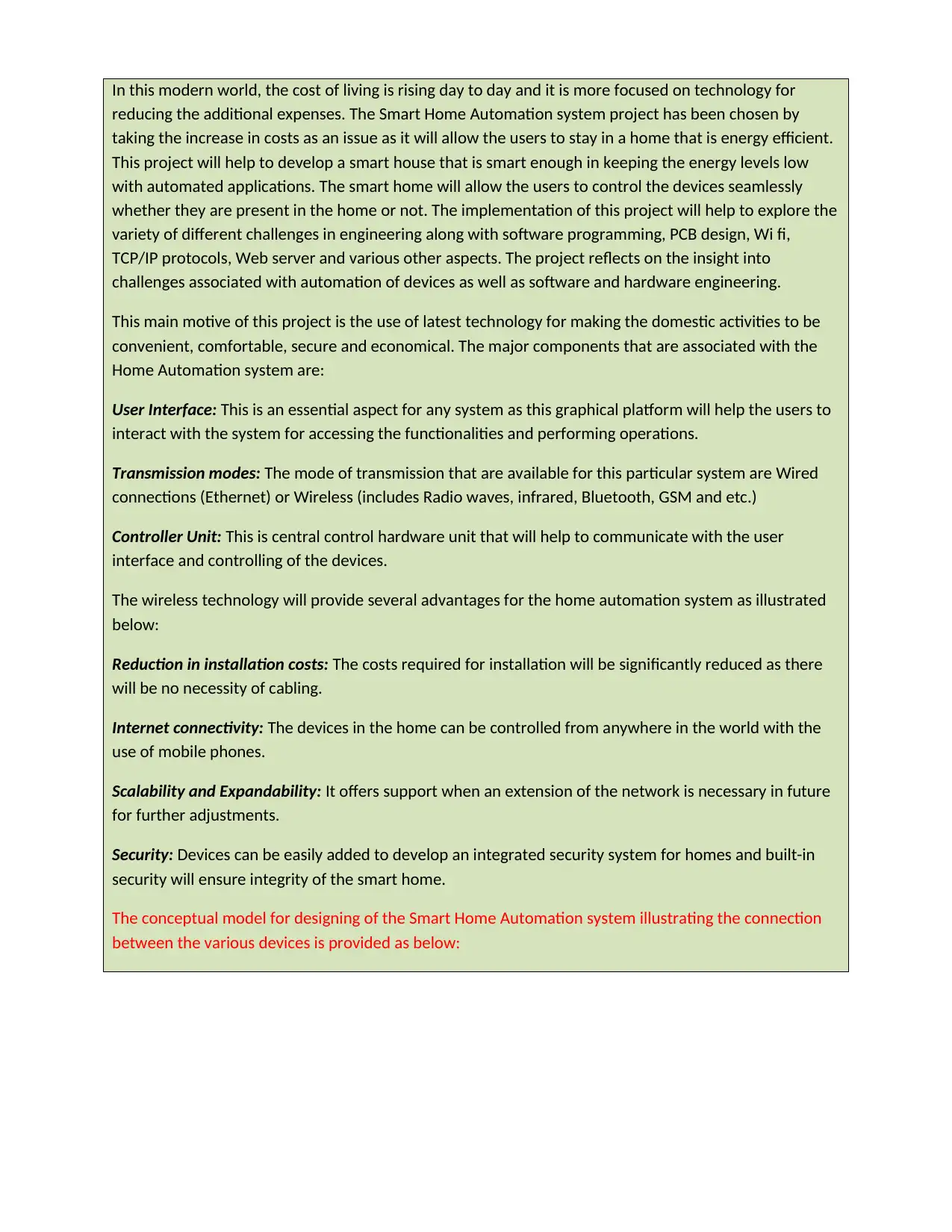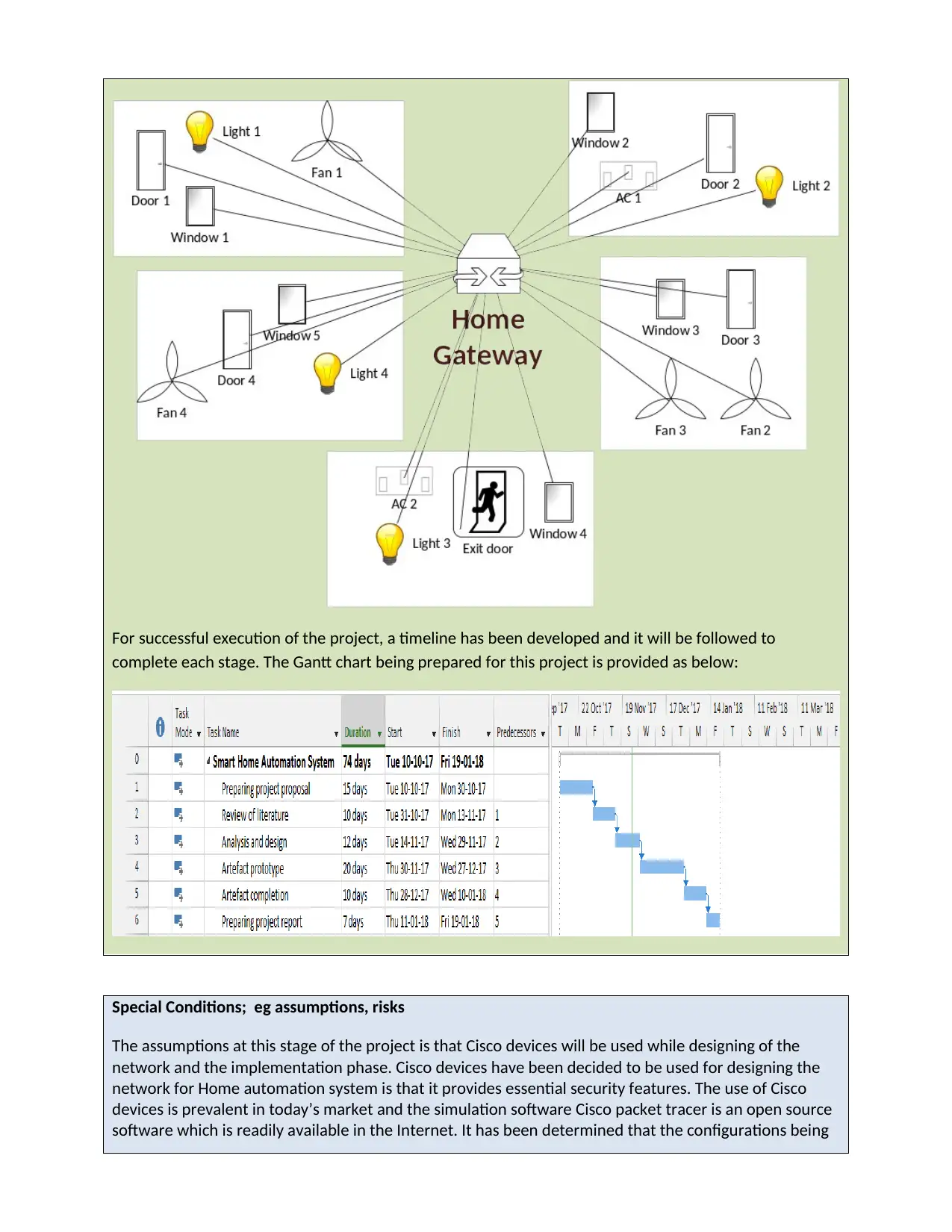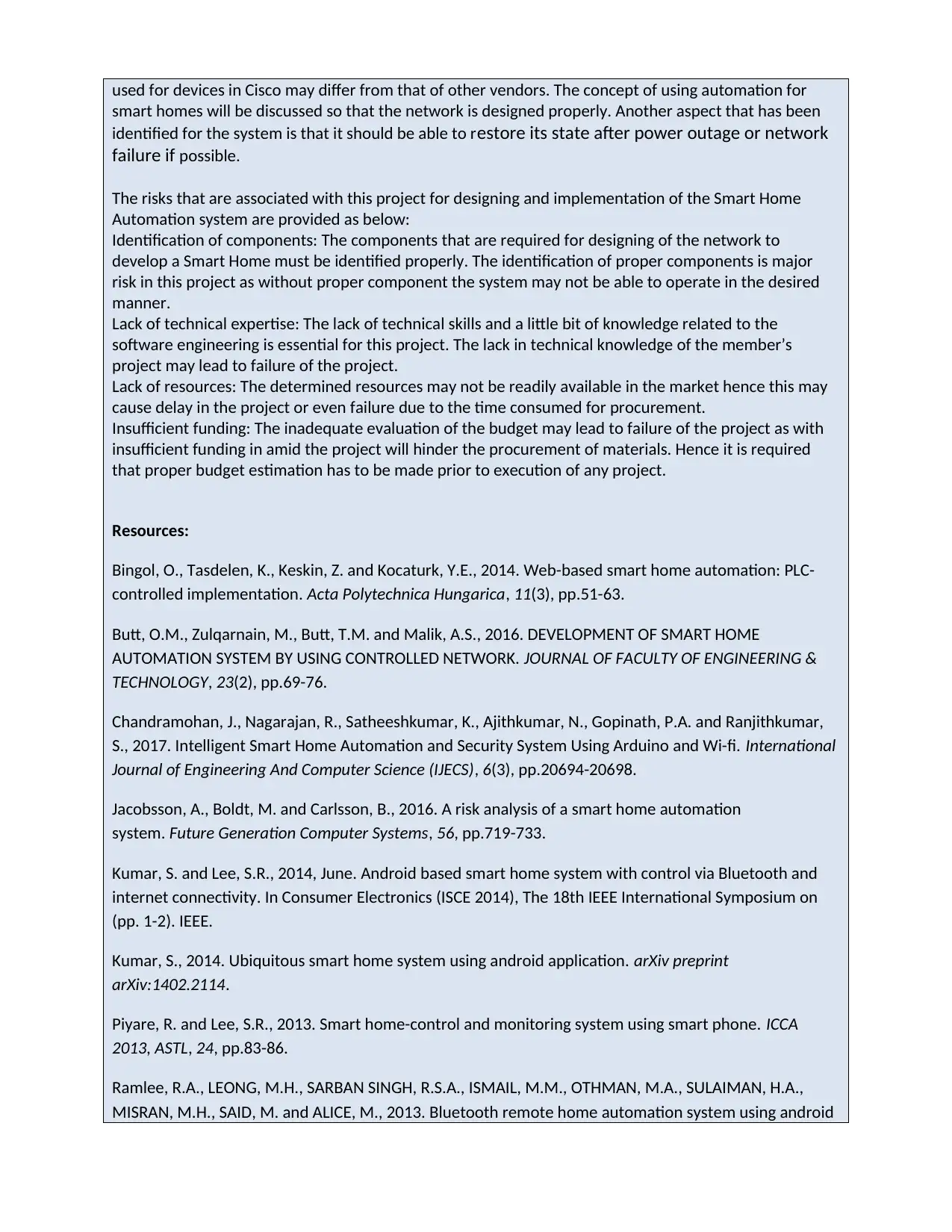HND Project: Design and Implementation of Smart Home Automation System
VerifiedAdded on 2020/04/21
|5
|1623
|81
Project
AI Summary
This project specification document outlines the design and implementation of a Smart Home Automation System for an HND Network Engineering and Telecommunication Systems pathway. The aim is to create a system for automatic and remote control of home appliances, addressing the manual control issues and promoting energy efficiency. Objectives include network design, requirement analysis, simulation using Cisco Packet Tracer, testing methods, and project evaluation. The project explores challenges in engineering, software programming, and various protocols. It uses wireless technology for reduced installation costs, internet connectivity, scalability, and security. The document includes a conceptual model, timeline, risk assessment, and resources. The project aims to make domestic activities convenient, comfortable, secure, and economical. The project will be evaluated to determine whether the aim has been achieved and whether the project was beneficial from the personal view of the project manager/developer.

PROJECT SPECIFICATION DOCUMENT
Student Name: [Please Fill] Student ID: [Please Fill]
Project Title: Design and Implementation of Smart Home Automation System
Pathway: HND Network Engineering and Telecommunication Systems
AIM:
The aim of this project is to design and implement a solution for automatic or remote control of
appliances in home. This project will help to eliminate the problem of manually switching on or off a
device every time it is accessed by the user. The devices or appliances being installed in a home will be
controlled automatically as well as manually as and when required by the user.
Objectives:
To eliminate the issues with manual controlling of devices in a home.
To analyze and design a network for implementing Smart Home Automation system that means
automatic control of the devices in a home.
To determine the functional and non-functional requirements in context to design of the
network for automatic controlling of the devices.
To implement the designed network using simulation software Cisco Packet Tracer 7.0 and
documenting the configuration of devices with the help of screenshots.
To identify and illustrate the testing methods that will be used to check the configuration of
devices that are implemented in the network.
To evaluate the objectives identified from different perspectives to determine success of the
project.
To draw a conclusion to the project and discuss whether the aim has been achieved. The
evaluation of the objectives will be conducted from different perspectives.
To analyze whether the project was beneficial from the personal view of the project
manager/developer.
Brief Description:
Student Name: [Please Fill] Student ID: [Please Fill]
Project Title: Design and Implementation of Smart Home Automation System
Pathway: HND Network Engineering and Telecommunication Systems
AIM:
The aim of this project is to design and implement a solution for automatic or remote control of
appliances in home. This project will help to eliminate the problem of manually switching on or off a
device every time it is accessed by the user. The devices or appliances being installed in a home will be
controlled automatically as well as manually as and when required by the user.
Objectives:
To eliminate the issues with manual controlling of devices in a home.
To analyze and design a network for implementing Smart Home Automation system that means
automatic control of the devices in a home.
To determine the functional and non-functional requirements in context to design of the
network for automatic controlling of the devices.
To implement the designed network using simulation software Cisco Packet Tracer 7.0 and
documenting the configuration of devices with the help of screenshots.
To identify and illustrate the testing methods that will be used to check the configuration of
devices that are implemented in the network.
To evaluate the objectives identified from different perspectives to determine success of the
project.
To draw a conclusion to the project and discuss whether the aim has been achieved. The
evaluation of the objectives will be conducted from different perspectives.
To analyze whether the project was beneficial from the personal view of the project
manager/developer.
Brief Description:
Paraphrase This Document
Need a fresh take? Get an instant paraphrase of this document with our AI Paraphraser

In this modern world, the cost of living is rising day to day and it is more focused on technology for
reducing the additional expenses. The Smart Home Automation system project has been chosen by
taking the increase in costs as an issue as it will allow the users to stay in a home that is energy efficient.
This project will help to develop a smart house that is smart enough in keeping the energy levels low
with automated applications. The smart home will allow the users to control the devices seamlessly
whether they are present in the home or not. The implementation of this project will help to explore the
variety of different challenges in engineering along with software programming, PCB design, Wi fi,
TCP/IP protocols, Web server and various other aspects. The project reflects on the insight into
challenges associated with automation of devices as well as software and hardware engineering.
This main motive of this project is the use of latest technology for making the domestic activities to be
convenient, comfortable, secure and economical. The major components that are associated with the
Home Automation system are:
User Interface: This is an essential aspect for any system as this graphical platform will help the users to
interact with the system for accessing the functionalities and performing operations.
Transmission modes: The mode of transmission that are available for this particular system are Wired
connections (Ethernet) or Wireless (includes Radio waves, infrared, Bluetooth, GSM and etc.)
Controller Unit: This is central control hardware unit that will help to communicate with the user
interface and controlling of the devices.
The wireless technology will provide several advantages for the home automation system as illustrated
below:
Reduction in installation costs: The costs required for installation will be significantly reduced as there
will be no necessity of cabling.
Internet connectivity: The devices in the home can be controlled from anywhere in the world with the
use of mobile phones.
Scalability and Expandability: It offers support when an extension of the network is necessary in future
for further adjustments.
Security: Devices can be easily added to develop an integrated security system for homes and built-in
security will ensure integrity of the smart home.
The conceptual model for designing of the Smart Home Automation system illustrating the connection
between the various devices is provided as below:
reducing the additional expenses. The Smart Home Automation system project has been chosen by
taking the increase in costs as an issue as it will allow the users to stay in a home that is energy efficient.
This project will help to develop a smart house that is smart enough in keeping the energy levels low
with automated applications. The smart home will allow the users to control the devices seamlessly
whether they are present in the home or not. The implementation of this project will help to explore the
variety of different challenges in engineering along with software programming, PCB design, Wi fi,
TCP/IP protocols, Web server and various other aspects. The project reflects on the insight into
challenges associated with automation of devices as well as software and hardware engineering.
This main motive of this project is the use of latest technology for making the domestic activities to be
convenient, comfortable, secure and economical. The major components that are associated with the
Home Automation system are:
User Interface: This is an essential aspect for any system as this graphical platform will help the users to
interact with the system for accessing the functionalities and performing operations.
Transmission modes: The mode of transmission that are available for this particular system are Wired
connections (Ethernet) or Wireless (includes Radio waves, infrared, Bluetooth, GSM and etc.)
Controller Unit: This is central control hardware unit that will help to communicate with the user
interface and controlling of the devices.
The wireless technology will provide several advantages for the home automation system as illustrated
below:
Reduction in installation costs: The costs required for installation will be significantly reduced as there
will be no necessity of cabling.
Internet connectivity: The devices in the home can be controlled from anywhere in the world with the
use of mobile phones.
Scalability and Expandability: It offers support when an extension of the network is necessary in future
for further adjustments.
Security: Devices can be easily added to develop an integrated security system for homes and built-in
security will ensure integrity of the smart home.
The conceptual model for designing of the Smart Home Automation system illustrating the connection
between the various devices is provided as below:

For successful execution of the project, a timeline has been developed and it will be followed to
complete each stage. The Gantt chart being prepared for this project is provided as below:
Special Conditions; eg assumptions, risks
The assumptions at this stage of the project is that Cisco devices will be used while designing of the
network and the implementation phase. Cisco devices have been decided to be used for designing the
network for Home automation system is that it provides essential security features. The use of Cisco
devices is prevalent in today’s market and the simulation software Cisco packet tracer is an open source
software which is readily available in the Internet. It has been determined that the configurations being
complete each stage. The Gantt chart being prepared for this project is provided as below:
Special Conditions; eg assumptions, risks
The assumptions at this stage of the project is that Cisco devices will be used while designing of the
network and the implementation phase. Cisco devices have been decided to be used for designing the
network for Home automation system is that it provides essential security features. The use of Cisco
devices is prevalent in today’s market and the simulation software Cisco packet tracer is an open source
software which is readily available in the Internet. It has been determined that the configurations being
⊘ This is a preview!⊘
Do you want full access?
Subscribe today to unlock all pages.

Trusted by 1+ million students worldwide

used for devices in Cisco may differ from that of other vendors. The concept of using automation for
smart homes will be discussed so that the network is designed properly. Another aspect that has been
identified for the system is that it should be able to restore its state after power outage or network
failure if possible.
The risks that are associated with this project for designing and implementation of the Smart Home
Automation system are provided as below:
Identification of components: The components that are required for designing of the network to
develop a Smart Home must be identified properly. The identification of proper components is major
risk in this project as without proper component the system may not be able to operate in the desired
manner.
Lack of technical expertise: The lack of technical skills and a little bit of knowledge related to the
software engineering is essential for this project. The lack in technical knowledge of the member’s
project may lead to failure of the project.
Lack of resources: The determined resources may not be readily available in the market hence this may
cause delay in the project or even failure due to the time consumed for procurement.
Insufficient funding: The inadequate evaluation of the budget may lead to failure of the project as with
insufficient funding in amid the project will hinder the procurement of materials. Hence it is required
that proper budget estimation has to be made prior to execution of any project.
Resources:
Bingol, O., Tasdelen, K., Keskin, Z. and Kocaturk, Y.E., 2014. Web-based smart home automation: PLC-
controlled implementation. Acta Polytechnica Hungarica, 11(3), pp.51-63.
Butt, O.M., Zulqarnain, M., Butt, T.M. and Malik, A.S., 2016. DEVELOPMENT OF SMART HOME
AUTOMATION SYSTEM BY USING CONTROLLED NETWORK. JOURNAL OF FACULTY OF ENGINEERING &
TECHNOLOGY, 23(2), pp.69-76.
Chandramohan, J., Nagarajan, R., Satheeshkumar, K., Ajithkumar, N., Gopinath, P.A. and Ranjithkumar,
S., 2017. Intelligent Smart Home Automation and Security System Using Arduino and Wi-fi. International
Journal of Engineering And Computer Science (IJECS), 6(3), pp.20694-20698.
Jacobsson, A., Boldt, M. and Carlsson, B., 2016. A risk analysis of a smart home automation
system. Future Generation Computer Systems, 56, pp.719-733.
Kumar, S. and Lee, S.R., 2014, June. Android based smart home system with control via Bluetooth and
internet connectivity. In Consumer Electronics (ISCE 2014), The 18th IEEE International Symposium on
(pp. 1-2). IEEE.
Kumar, S., 2014. Ubiquitous smart home system using android application. arXiv preprint
arXiv:1402.2114.
Piyare, R. and Lee, S.R., 2013. Smart home-control and monitoring system using smart phone. ICCA
2013, ASTL, 24, pp.83-86.
Ramlee, R.A., LEONG, M.H., SARBAN SINGH, R.S.A., ISMAIL, M.M., OTHMAN, M.A., SULAIMAN, H.A.,
MISRAN, M.H., SAID, M. and ALICE, M., 2013. Bluetooth remote home automation system using android
smart homes will be discussed so that the network is designed properly. Another aspect that has been
identified for the system is that it should be able to restore its state after power outage or network
failure if possible.
The risks that are associated with this project for designing and implementation of the Smart Home
Automation system are provided as below:
Identification of components: The components that are required for designing of the network to
develop a Smart Home must be identified properly. The identification of proper components is major
risk in this project as without proper component the system may not be able to operate in the desired
manner.
Lack of technical expertise: The lack of technical skills and a little bit of knowledge related to the
software engineering is essential for this project. The lack in technical knowledge of the member’s
project may lead to failure of the project.
Lack of resources: The determined resources may not be readily available in the market hence this may
cause delay in the project or even failure due to the time consumed for procurement.
Insufficient funding: The inadequate evaluation of the budget may lead to failure of the project as with
insufficient funding in amid the project will hinder the procurement of materials. Hence it is required
that proper budget estimation has to be made prior to execution of any project.
Resources:
Bingol, O., Tasdelen, K., Keskin, Z. and Kocaturk, Y.E., 2014. Web-based smart home automation: PLC-
controlled implementation. Acta Polytechnica Hungarica, 11(3), pp.51-63.
Butt, O.M., Zulqarnain, M., Butt, T.M. and Malik, A.S., 2016. DEVELOPMENT OF SMART HOME
AUTOMATION SYSTEM BY USING CONTROLLED NETWORK. JOURNAL OF FACULTY OF ENGINEERING &
TECHNOLOGY, 23(2), pp.69-76.
Chandramohan, J., Nagarajan, R., Satheeshkumar, K., Ajithkumar, N., Gopinath, P.A. and Ranjithkumar,
S., 2017. Intelligent Smart Home Automation and Security System Using Arduino and Wi-fi. International
Journal of Engineering And Computer Science (IJECS), 6(3), pp.20694-20698.
Jacobsson, A., Boldt, M. and Carlsson, B., 2016. A risk analysis of a smart home automation
system. Future Generation Computer Systems, 56, pp.719-733.
Kumar, S. and Lee, S.R., 2014, June. Android based smart home system with control via Bluetooth and
internet connectivity. In Consumer Electronics (ISCE 2014), The 18th IEEE International Symposium on
(pp. 1-2). IEEE.
Kumar, S., 2014. Ubiquitous smart home system using android application. arXiv preprint
arXiv:1402.2114.
Piyare, R. and Lee, S.R., 2013. Smart home-control and monitoring system using smart phone. ICCA
2013, ASTL, 24, pp.83-86.
Ramlee, R.A., LEONG, M.H., SARBAN SINGH, R.S.A., ISMAIL, M.M., OTHMAN, M.A., SULAIMAN, H.A.,
MISRAN, M.H., SAID, M. and ALICE, M., 2013. Bluetooth remote home automation system using android
Paraphrase This Document
Need a fresh take? Get an instant paraphrase of this document with our AI Paraphraser

application.
Teymourzadeh, R., Ahmed, S.A., Chan, K.W. and Hoong, M.V., 2013, December. Smart gsm based home
automation system. In Systems, Process & Control (ICSPC), 2013 IEEE Conference on (pp. 306-309). IEEE.
Comments:
SIGNED OFF: STUDENT: DATE:
Project Supervisor
Teymourzadeh, R., Ahmed, S.A., Chan, K.W. and Hoong, M.V., 2013, December. Smart gsm based home
automation system. In Systems, Process & Control (ICSPC), 2013 IEEE Conference on (pp. 306-309). IEEE.
Comments:
SIGNED OFF: STUDENT: DATE:
Project Supervisor
1 out of 5
Related Documents
Your All-in-One AI-Powered Toolkit for Academic Success.
+13062052269
info@desklib.com
Available 24*7 on WhatsApp / Email
![[object Object]](/_next/static/media/star-bottom.7253800d.svg)
Unlock your academic potential
Copyright © 2020–2025 A2Z Services. All Rights Reserved. Developed and managed by ZUCOL.





